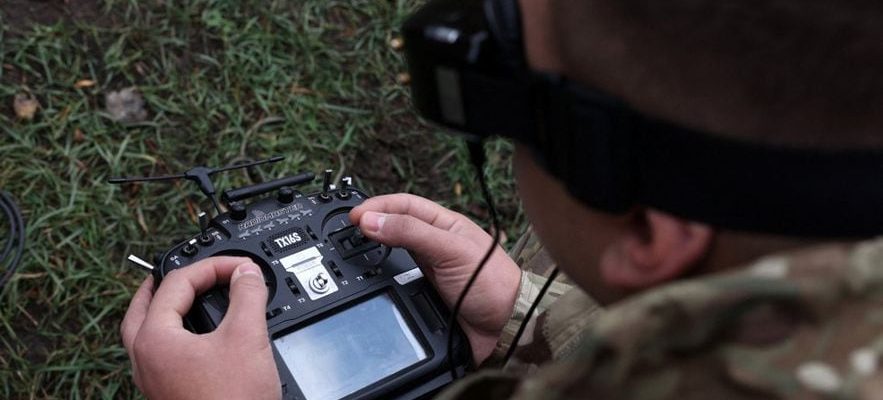The Russian T-80 tank advances in a straight line on a snow-covered path, not far from Avdiivka, in the Donetsk region. A Ukrainian drone appears, chases it, then, equipped with its explosive charge, hits its rear armor, right at the junction between its chassis and its turret: its weak point. The armored vehicle immediately disappeared in a huge shower of flames, probably caused by the explosion of its own ammunition.
At the origin of this scene captured in mid-January in eastern Ukraine, the attack of an FPV drone (for “first-person view”, which can be translated as “subjective view” or “immersion flight”), a formidable weapon increasingly used on the front by both camps. “These are generally small civilian racing drones very fast and very maneuverable which have been modified to be able to transport explosives, details Yohann Michel, researcher on defense issues at the International Institute for Strategic Studies (IISS). This allows them to hit targets with great precision, even if they are moving.”
Controlled remotely by an operator equipped with virtual reality glasses, connected in real time to the camera installed on the front of the device, the FPV drones – which can move at more than 100 kilometers/hour – are capable of operate in areas that are particularly difficult to access. “They can sneak into a bunker or a trench and come and hit places that are difficult for artillery to reach,” illustrates Léo Péria-Peigné, arms and foresight researcher at the French Institute of International Relations (Ifri).
“It’s like you’re walking into a hornet’s nest.”
Their effectiveness on the battlefield no longer needs to be demonstrated. “FPV drones are used in conjunction with artillery to target Russian force vehicles, pointed out in a recent note British intelligence. A Russian military blogger estimates that 90% of Russian military equipment in the Krynky sector [Sud-Ouest] was destroyed.”
Another significant advantage: their cost. The price of a machine thus ranges between 500 and 1,000 euros depending on the model, compared to around 8,000 euros for a 155 mm shell, stocks of which are becoming scarce after almost two years of war. “A small drone costing a few hundred euros can defeat a tank worth several million,” emphasizes Xavier Tytelman, former military aviator and aeronautical expert. But they are also used directly against soldiers thanks to specific charges containing shrapnel. [munitions libérant des fragments lors de l’explosion].”
A Ukrainian FPV drone operator trains near the front line in the Donetsk region on November 16, 2023.
© / AFP
A nightmare for the troops engaged on the front. “There are a lot of enemy drones. When you enter a village on the front line, it’s like you’re entering a hornet’s nest – everything is buzzing,” Dmitri warned on January 14 on the Telegram social network. Rogozin, former head of the Russian space agency Roscosmos, now senator of the occupied Zaporizhia region. At the entrance, enemy FPV drones are in service in the air. In pairs. One attacks immediately, the “The other adjusts its position at the point of impact, then attacks those who rush to the victim’s aid.”
Mass production
On social networks, images of their kamikaze strikes have become daily occurrences. To the point of damaging the morale of the combatants on both sides. “Simple drones already had a psychological impact, but it is multiplied with FPV drones: if you are targeted, you have little chance of surviving,” notes Léo Péria-Peigné, from Ifri. Which at the same time implies strengthening the means of fighting to protect against it. “This will require having electronic warfare systems at the lowest tactical level,” adds Yohann Michel, of the IISS, “like small jammers equipping all vehicles to ensure their protection.”
After almost two years of war, kyiv intends to intensify the use of FPV drones on the battlefield. On December 19, Volodymyr Zelensky set the goal of producing 1 million in 2024 (for comparison, 50,000 were manufactured in December). “This is an obvious priority for our country and a very concrete way to protect the lives of our soldiers,” assured the Ukrainian president. To drive the point home, the Deputy Prime Minister and Minister of Digital Transformation, Mykhaïlo Fedorov, even called in mid-January for all Ukrainians to follow training to learn how to assemble these machines at home, in order to then provide them to the army.
On the other hand, Russia has also intensified its efforts in this area. In 2023, “more than 3,500 FPV drone operators have been trained”, indicated the Ministry of Defense in early January. “The Russians were behind in this area, but they made big investments to try to catch up,” summarizes Xavier Tytelman. In the fall, a Russian designer announced the arrival of a drone equipped with thermal imaging, capable of operating at night. The race for technology has only just begun.
.
